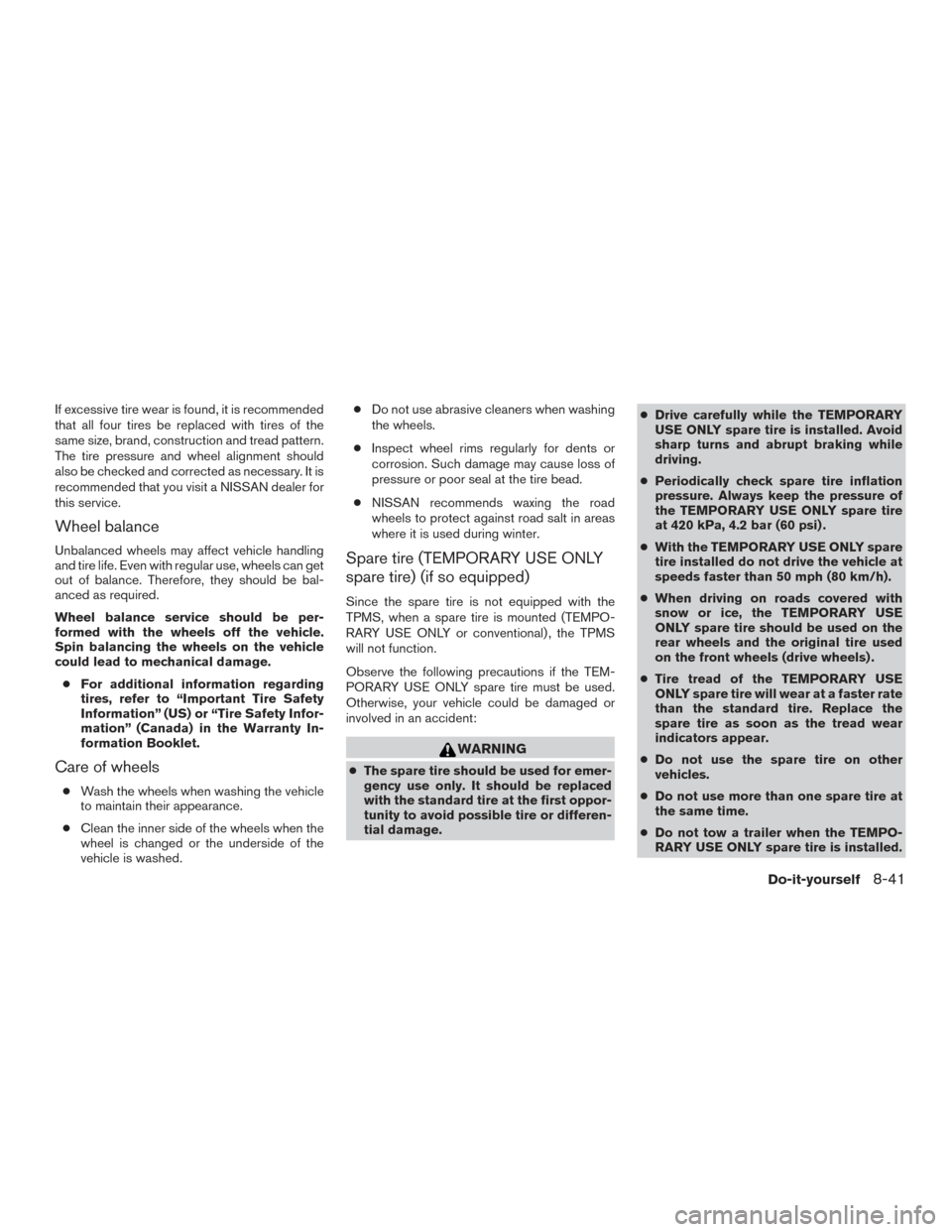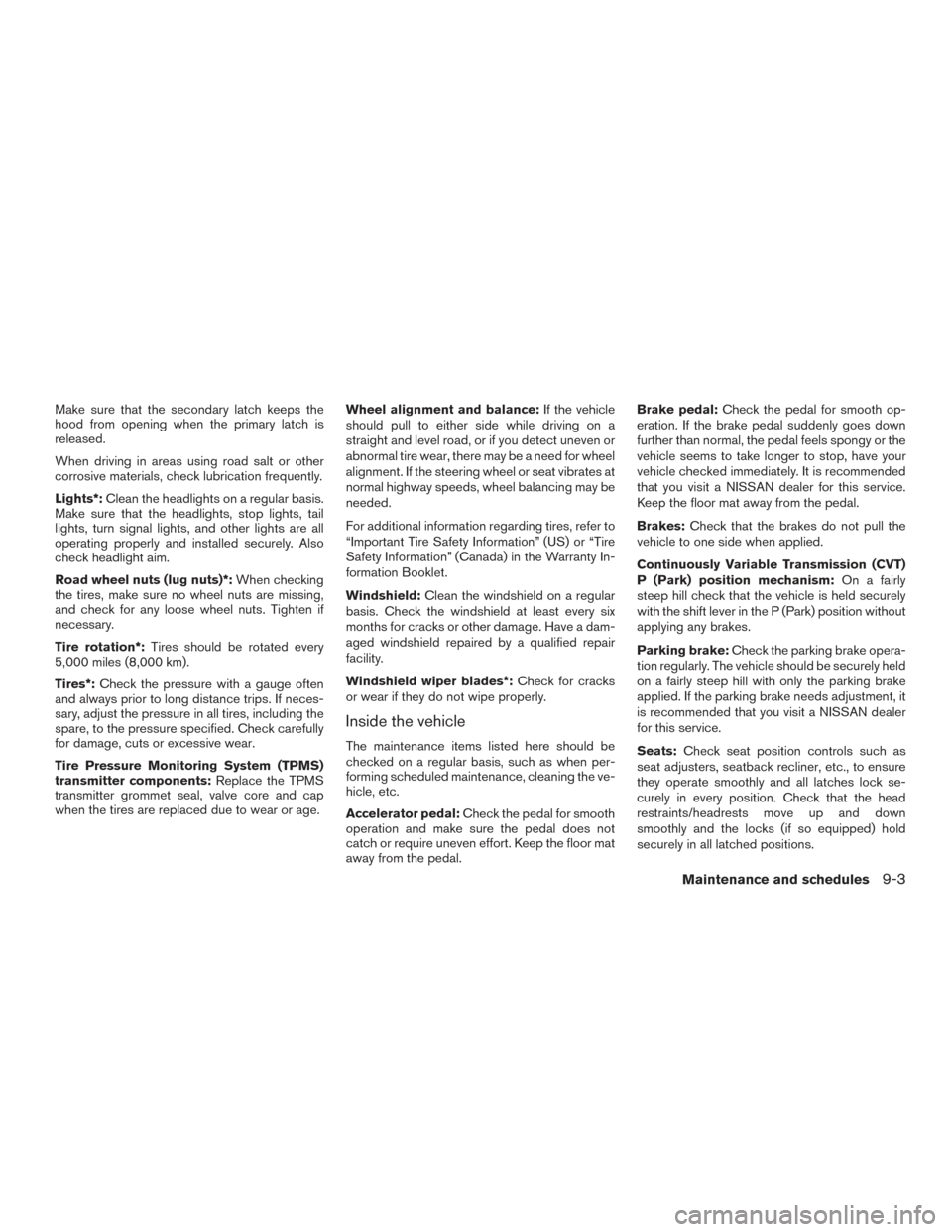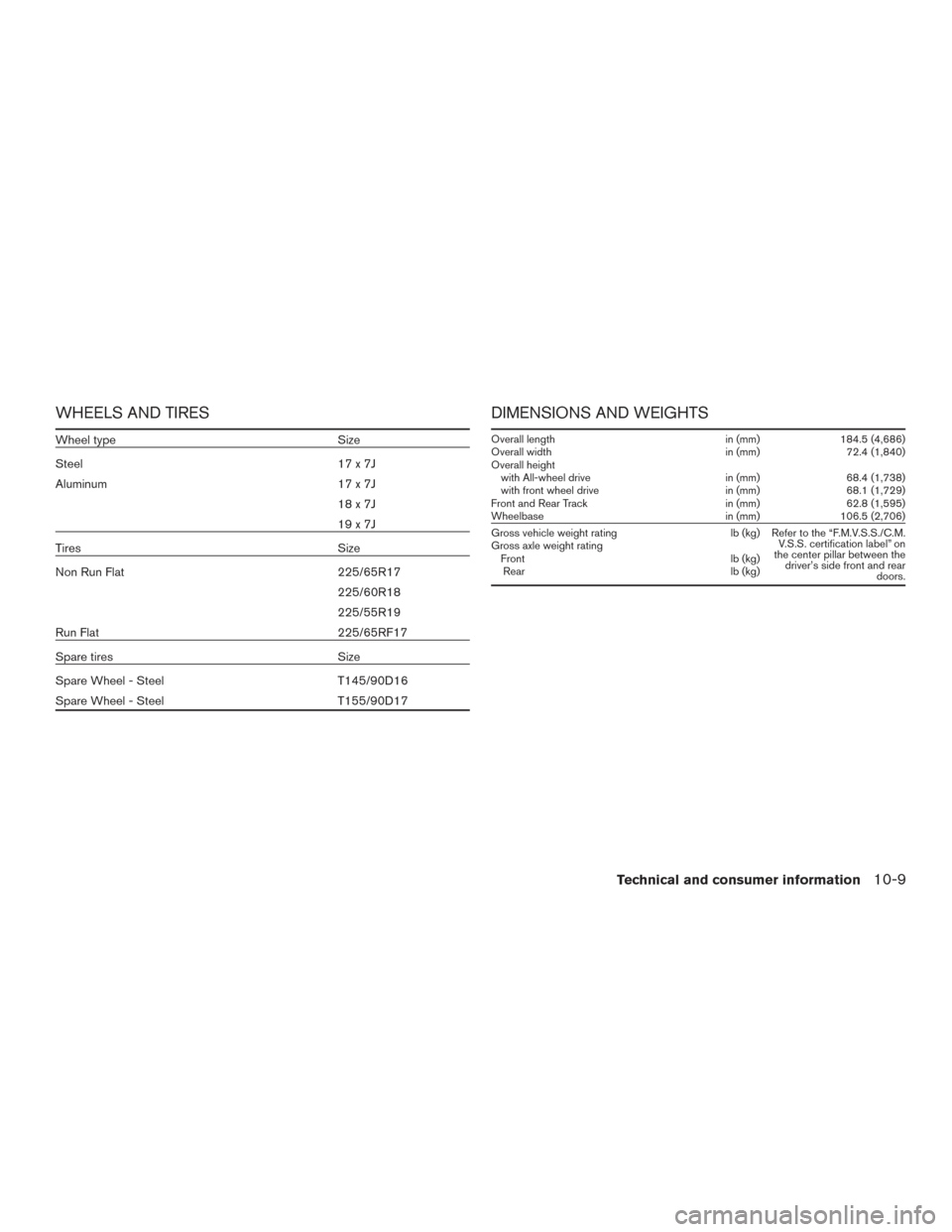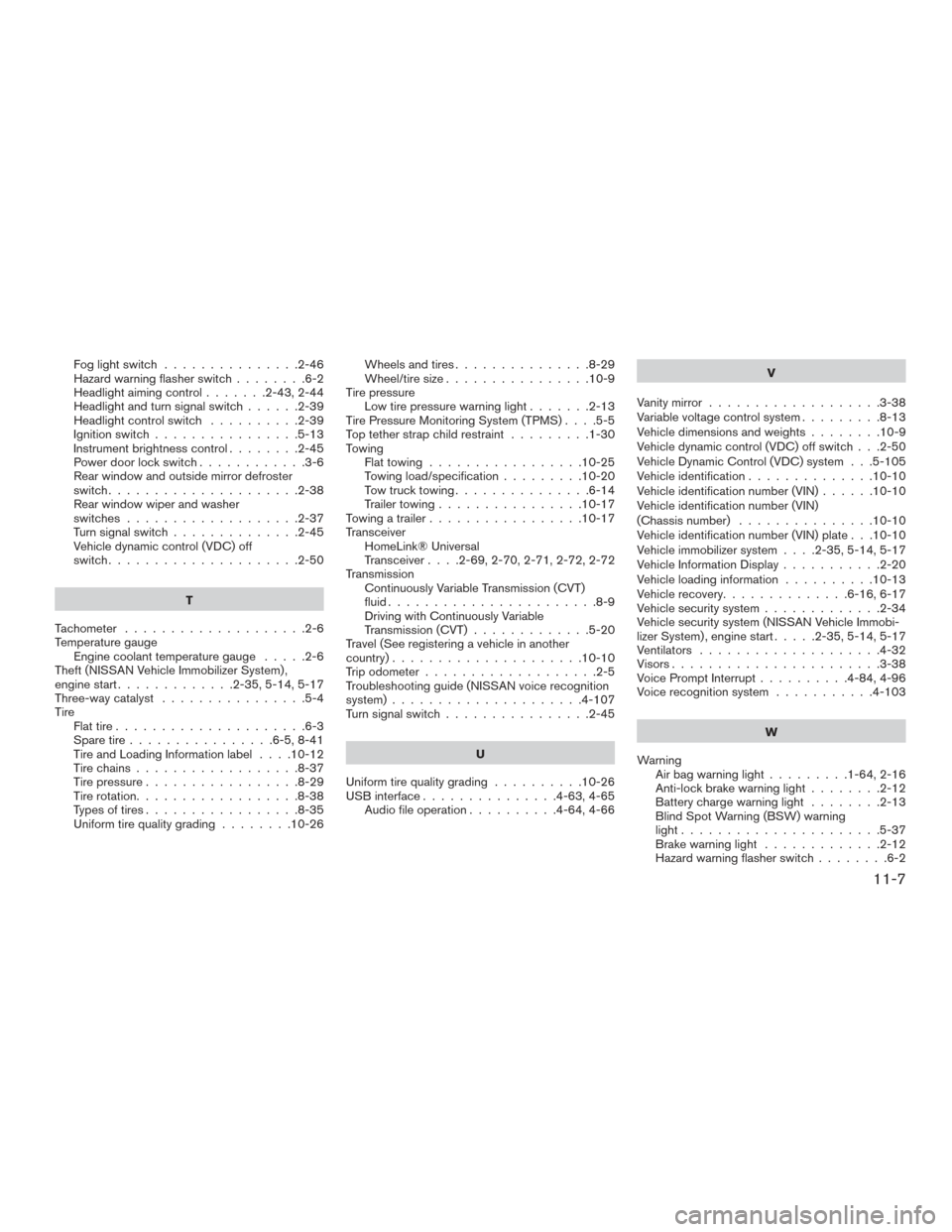2017 NISSAN ROGUE spare wheel
[x] Cancel search: spare wheelPage 490 of 547

If excessive tire wear is found, it is recommended
that all four tires be replaced with tires of the
same size, brand, construction and tread pattern.
The tire pressure and wheel alignment should
also be checked and corrected as necessary. It is
recommended that you visit a NISSAN dealer for
this service.
Wheel balance
Unbalanced wheels may affect vehicle handling
and tire life. Even with regular use, wheels can get
out of balance. Therefore, they should be bal-
anced as required.
Wheel balance service should be per-
formed with the wheels off the vehicle.
Spin balancing the wheels on the vehicle
could lead to mechanical damage.● For additional information regarding
tires, refer to “Important Tire Safety
Information” (US) or “Tire Safety Infor-
mation” (Canada) in the Warranty In-
formation Booklet.
Care of wheels
● Wash the wheels when washing the vehicle
to maintain their appearance.
● Clean the inner side of the wheels when the
wheel is changed or the underside of the
vehicle is washed. ●
Do not use abrasive cleaners when washing
the wheels.
● Inspect wheel rims regularly for dents or
corrosion. Such damage may cause loss of
pressure or poor seal at the tire bead.
● NISSAN recommends waxing the road
wheels to protect against road salt in areas
where it is used during winter.
Spare tire (TEMPORARY USE ONLY
spare tire) (if so equipped)
Since the spare tire is not equipped with the
TPMS, when a spare tire is mounted (TEMPO-
RARY USE ONLY or conventional) , the TPMS
will not function.
Observe the following precautions if the TEM-
PORARY USE ONLY spare tire must be used.
Otherwise, your vehicle could be damaged or
involved in an accident:
WARNING
● The spare tire should be used for emer-
gency use only. It should be replaced
with the standard tire at the first oppor-
tunity to avoid possible tire or differen-
tial damage. ●
Drive carefully while the TEMPORARY
USE ONLY spare tire is installed. Avoid
sharp turns and abrupt braking while
driving.
● Periodically check spare tire inflation
pressure. Always keep the pressure of
the TEMPORARY USE ONLY spare tire
at 420 kPa, 4.2 bar (60 psi) .
● With the TEMPORARY USE ONLY spare
tire installed do not drive the vehicle at
speeds faster than 50 mph (80 km/h).
● When driving on roads covered with
snow or ice, the TEMPORARY USE
ONLY spare tire should be used on the
rear wheels and the original tire used
on the front wheels (drive wheels) .
● Tire tread of the TEMPORARY USE
ONLY spare tire will wear at a faster rate
than the standard tire. Replace the
spare tire as soon as the tread wear
indicators appear.
● Do not use the spare tire on other
vehicles.
● Do not use more than one spare tire at
the same time.
● Do not tow a trailer when the TEMPO-
RARY USE ONLY spare tire is installed.
Do-it-yourself8-41
Page 494 of 547

Make sure that the secondary latch keeps the
hood from opening when the primary latch is
released.
When driving in areas using road salt or other
corrosive materials, check lubrication frequently.
Lights*:Clean the headlights on a regular basis.
Make sure that the headlights, stop lights, tail
lights, turn signal lights, and other lights are all
operating properly and installed securely. Also
check headlight aim.
Road wheel nuts (lug nuts)*: When checking
the tires, make sure no wheel nuts are missing,
and check for any loose wheel nuts. Tighten if
necessary.
Tire rotation*: Tires should be rotated every
5,000 miles (8,000 km).
Tires*: Check the pressure with a gauge often
and always prior to long distance trips. If neces-
sary, adjust the pressure in all tires, including the
spare, to the pressure specified. Check carefully
for damage, cuts or excessive wear.
Tire Pressure Monitoring System (TPMS)
transmitter components: Replace the TPMS
transmitter grommet seal, valve core and cap
when the tires are replaced due to wear or age. Wheel alignment and balance:
If the vehicle
should pull to either side while driving on a
straight and level road, or if you detect uneven or
abnormal tire wear, there may be a need for wheel
alignment. If the steering wheel or seat vibrates at
normal highway speeds, wheel balancing may be
needed.
For additional information regarding tires, refer to
“Important Tire Safety Information” (US) or “Tire
Safety Information” (Canada) in the Warranty In-
formation Booklet.
Windshield: Clean the windshield on a regular
basis. Check the windshield at least every six
months for cracks or other damage. Have a dam-
aged windshield repaired by a qualified repair
facility.
Windshield wiper blades*: Check for cracks
or wear if they do not wipe properly.
Inside the vehicle
The maintenance items listed here should be
checked on a regular basis, such as when per-
forming scheduled maintenance, cleaning the ve-
hicle, etc.
Accelerator pedal: Check the pedal for smooth
operation and make sure the pedal does not
catch or require uneven effort. Keep the floor mat
away from the pedal. Brake pedal:
Check the pedal for smooth op-
eration. If the brake pedal suddenly goes down
further than normal, the pedal feels spongy or the
vehicle seems to take longer to stop, have your
vehicle checked immediately. It is recommended
that you visit a NISSAN dealer for this service.
Keep the floor mat away from the pedal.
Brakes: Check that the brakes do not pull the
vehicle to one side when applied.
Continuously Variable Transmission (CVT)
P (Park) position mechanism: On a fairly
steep hill check that the vehicle is held securely
with the shift lever in the P (Park) position without
applying any brakes.
Parking brake: Check the parking brake opera-
tion regularly. The vehicle should be securely held
on a fairly steep hill with only the parking brake
applied. If the parking brake needs adjustment, it
is recommended that you visit a NISSAN dealer
for this service.
Seats: Check seat position controls such as
seat adjusters, seatback recliner, etc., to ensure
they operate smoothly and all latches lock se-
curely in every position. Check that the head
restraints/headrests move up and down
smoothly and the locks (if so equipped) hold
securely in all latched positions.
Maintenance and schedules9-3
Page 516 of 547

WHEELS AND TIRES
Wheel typeSize
Steel 17 x 7J
Aluminum 17 x 7J
18x7J
19x7J
Tires Size
Non Run Flat 225/65R17
225/60R18
225/55R19
Run Flat 225/65RF17
Spare tires Size
Spare Wheel - Steel T145/90D16
Spare Wheel - Steel T155/90D17
DIMENSIONS AND WEIGHTS
Overall lengthin (mm)184.5 (4,686)
Overall width in (mm)72.4 (1,840)
Overall height with All-wheel drive in (mm)68.4 (1,738)
with front wheel drive in (mm)68.1 (1,729)
Front and Rear Track in (mm)62.8 (1,595)
Wheelbase in (mm)106.5 (2,706)
Gross vehicle weight rating lb (kg) Refer to the “F.M.V.S.S./C.M.
V.S.S. certification label” on
the center pillar between the driver’s side front and rear doors.
Gross axle weight rating
Front lb (kg)
Rear lb (kg)
Technical and consumer information10-9
Page 544 of 547

Foglightswitch ...............2-46
Hazard warning flasher switch........6-2
Headlight aiming control .......2-43,2-44
Headlight and turn signal switch ......2-39
Headlight control switch ..........2-39
Ignition switch ................5-13
Instrument brightness control ........2-45
Power door lock switch ............3-6
Rear window and outside mirror defroster
switch.....................2-38
Rear window wiper and washer
switches ...................2-37
Turnsignalswitch..............2-45
Vehicle dynamic control (VDC) off
switch.....................2-50
T
Tachometer ....................2-6
Temperature gauge Engine coolant temperature gauge .....2-6
Theft (NISSAN Vehicle Immobilizer System) ,
engine start .............2-35,5-14,5-17
Three-way catalyst ................5-4
Tire Flat tire .....................6-3
Spare tire ................6-5,8-41
TireandLoadingInformationlabel ....10-12
Tire chains ..................8-37
Tirepressure.................8-29
Tire rotation..................8-38
Types of tires .................8-35
Uniform tire quality grading ........10-26Wheels and tires
...............8-29
Wheel/tire size ................10-9
Tire pressure Low tire pressure warning light .......2-13
Tire Pressure Monitoring System (TPMS) ....5-5
Top tether strap child restraint .........1-30
Towing Flattowing.................10-25
Towing load/specification .........10-20
Towtrucktowing...............6-14
Trailer towing ................10-17
Towing a trailer .................10-17
Transceiver HomeLink® Universal
Transceiver ....2-69,2-70,2-71,2-72,2-72
Transmission Continuously Variable Transmission (CVT)
fluid.......................8-9
Driving with Continuously Variable
Transmission (CVT) .............5-20
Travel (See registering a vehicle in another
country) .....................10-10
Trip odometer ...................2-5
Troubleshooting guide (NISSAN voice recognition
system) .....................4-107
Turn signal switch ................2-45
U
Uniform tire quality grading ..........10-26
USB interface ...............4-63,4-65
Audio file operation ..........4-64,4-66 V
Vanity mirror ...................3-38
Variable voltage control system .........8-13
Vehicle dimensions and weights ........10-9
Vehicle dynamic control (VDC) off switch . . .2-50
Vehicle Dynamic Control (VDC) system . . .5-105
Vehicle identification ..............10-10
Vehicle identification number (VIN) ......10-10
Vehicle identification number (VIN)
(Chassis number) ...............10-10
Vehicle identification number (VIN) plate . . .10-10
Vehicle immobilizer system ....2-35,5-14,5-17
Vehicle Information Display ...........2-20
Vehicle loading information ..........10-13
Vehicle recovery ..............6-16,6-17
V
ehicle security system .............2-34
Vehicle security system (NISSAN Vehicle Immobi-
lizer System) , engine start .....2-35,5-14,5-17
Ventilators ....................4-32
Visors.......................3-38
Voice Prompt Interrupt ..........4-84,4-96
Voice recognition system ...........4-103
W
Warning Airbagwarninglight.........1-64,2-16
Anti-lock brake warning light ........2-12
Battery charge warning light ........2-13
Blind Spot Warning (BSW) warning
light......................5-37
Brake warning light .............2-12
Hazard warning flasher switch ........6-2
11-7